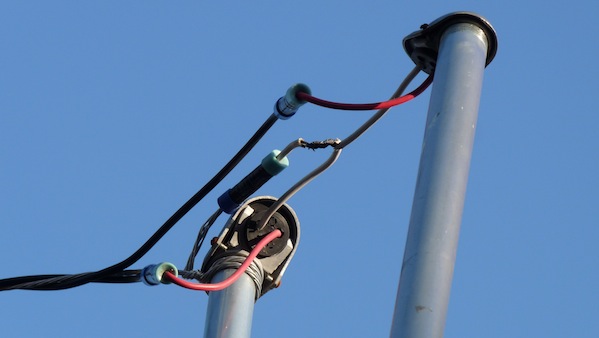This is the overview for the Mexican Residential Electrical course, now at 22,500 words and probably 85% complete. Their standards are identical to the copy of the 2002 NEC I have with me. Anyone care to comment?
Anyone want to review the course material for accuracy?
Generally, a residential electrical system forms a large loop. Electricity:
-
is supplied to the home through the service conductors, supplied by the CFE electrical power distribution lines; -
is distributed throughout the home by branch circuits; and -
after passing through the home electrical system, some electrical current returns from the home to the CFE power distribution cables. No one seems to know where it goes after that. Please, PLEASE don't tell me "they return to the source" unless you can name the specific type of source and explain why electrons would go there.
Let’s take a closer look at each of these steps. A typical, properly designed, installed and operating residential electrical system operates like this:
**1. **Electricity is supplied to the home through the service conductors.
Typical modern homes are connected to the CFE power distribution system by the service drop (installed overhead), or service lateral (installed underground) through three service conductors. Two of these conductors are phase conductors, each one supplying the home with approximately 127v of electrical current. The third conductor is the neutral service conductor, through which unused electricity returns to the CFE power distribution cables.
Overhead service drop conductors enter a weatherhead that is installed at the top of conduit that encloses the conductors, protecting them from weather, abrasion or impact damage and prevents people from touching them.
As service conductors in a service lateral emerge from the ground, they also enter a conduit that serves the same purpose as that serving the service drop; protection for both the conductors, and for people.
The conduit enclosing the service conductors is attached to a meter housing, and the electrical current passes through the meter, which records the amount of electricity used each month so that CFE can bill the customer accordingly. From the meter, conductors carry current to a service panel, which is a metal box containing electrical components that distribute electricity to different parts of the home.
**2. ****Electricity is distributed through the home by branch circuits. **
Each branch circuit forms a loop that supplies electricity to a terminal point that fees a load, like a refrigerator, light, or receptacle. In modern homes, each branch circuit typically consists of three or four conductors, depending on the power requirements for that circuit. Each branch circuit contains one or two ungrounded (hot) conductors, a grounded (neutral) conductor, and an equipment grounding conductor.
**3. **After passing through the home electrical system, some electrical current will return to the CFE power distribution lines.
When electricity is consumed at a branch circuit termination (like when an electric light is turned on), a connection is made between the ungrounded (hot) and grounded (neutral) conductors in that branch circuit and electricity flows through the circuit. 127v of current will enter the light, some electricity will be consumed by the light, and the portion that is not consumed will flow back through the neutral conductor of that branch circuit to the service panel and from there to the CFE power lines on the neutral service conductor.
Before 1997 no standards existed in México to act as guidelines for the installation, maintenance and repair of residential electrical systems. Lack of guidelines or inspection by a neutral third party when electrical work has been performed has resulted in widespread poor quality work and unsafe electrical conditions in residential properties across México.
Although the electrical Normas Officiales de México (NOM)-001-SEDE have been available since 1997, neutral third party inspection of electrical work performed during home construction or major changes or repairs do not exist, and realistically, adherence to the Normas is at the option of the builder. Because electrical system installation that complies with the Normas may be more expensive, with no oversight, builders often surrender to the temptation to accept sub-standard workmanship and materials.
Neutral third-party – A neutral third-party is an unbiased person with no financial interest in the result of an inspection.
Home inspection is not inspection for compliance with the Normas. It is inspection for electrical system and major component defects and safety issues. Because the Normas were designed to help ensure safe electrical conditions, the purposes of the Normas and of home inspections are very similar, but General Home Inspections according to the InterNACHI México Standards of Practice are not designed to identify violations of the Normas. The Standards act as minimum guidelines that describe the portions of a residential electrical system that inspectors must inspect and report on. The extent to which each inspector exceeds the Standards is a decision to be made be each individual inspector. InterNACHI México requires only that the inspection reports of members comply with the Standards of Practice.
Residential electrical systems are designed in specific ways and have various devices installed to reduce the dangers connected with electricity, including electrical shock/electrocution and fire. Electrical installation methods, materials, and components have changed over the years as the understanding of electrical systems has improved and materials and components have become more sophisticated.
In the following sections of this course we will cover inspection of new and existing residential electrical systems, including the system and component configurations you should see, and common defective conditions.
